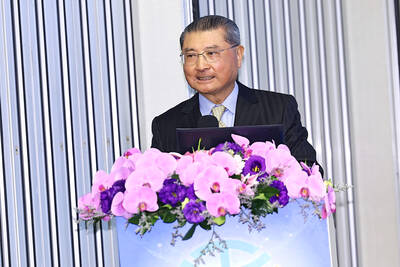Taiwan’s GDP per capita has surpassed South Korea’s for the first time since 2004, the Ministry of Economic Affairs said on Friday.
The national GDP per capita stood at US $32,811 last year, compared with South Korea’s US$32,237, the ministry said.
The government compares and contrasts the two countries given their similar population density, economic development models and industrial structure, it said.

Photo: Lee Hui-chou, Taipei Times
Taiwan’s economy grew by 3.2 percent each year on average from 2013 to last year, also higher than South Korea’s annual average of 2.6 percent, it added.
While manufacturing value added (MVA) accounted for 29.1 percent of Taiwan’s GDP in 2013, the figure rose to 34.2 percent last year, the ministry said.
Meanwhile, South Korea’s MVA contracted from 27.8 percent to 25.6 percent over the period, it said.
Taiwan’s MVA rate has outpaced South Korea’s since 2015 and reached 32.5 percent in 2020, when South Korea’s rate was 28.7 percent, it said.
Taiwan’s industrial competitiveness was boosted by China-based Taiwanese businesses returning home during the COVID-19 pandemic, and due to US-China trade tensions over the past five years, the ministry said.
The nation’s exports grew 4.6 percent on average each year from 2013 to last year, more than South Korea’s 2.2 percent and the global average of 3 percent, it said.
The total value of South Korean exports last year amounted to 140 percent of Taiwan’s exports, narrowing from 180 percent in 2013.
Taiwan’s advantage in the semiconductor industry gave it a trade surplus of US$51.4 billion last year, while South Korea, affected by COVID-19 lockdowns in China and rising energy costs, recorded a trade deficit of US$47.8 billion, the ministry said.

When an apartment comes up for rent in Germany’s big cities, hundreds of prospective tenants often queue down the street to view it, but the acute shortage of affordable housing is getting scant attention ahead of today’s snap general election. “Housing is one of the main problems for people, but nobody talks about it, nobody takes it seriously,” said Andreas Ibel, president of Build Europe, an association representing housing developers. Migration and the sluggish economy top the list of voters’ concerns, but analysts say housing policy fails to break through as returns on investment take time to register, making the

‘SILVER LINING’: Although the news caused TSMC to fall on the local market, an analyst said that as tariffs are not set to go into effect until April, there is still time for negotiations US President Donald Trump on Tuesday said that he would likely impose tariffs on semiconductor, automobile and pharmaceutical imports of about 25 percent, with an announcement coming as soon as April 2 in a move that would represent a dramatic widening of the US leader’s trade war. “I probably will tell you that on April 2, but it’ll be in the neighborhood of 25 percent,” Trump told reporters at his Mar-a-Lago club when asked about his plan for auto tariffs. Asked about similar levies on pharmaceutical drugs and semiconductors, the president said that “it’ll be 25 percent and higher, and it’ll

CHIP BOOM: Revenue for the semiconductor industry is set to reach US$1 trillion by 2032, opening up opportunities for the chip pacakging and testing company, it said ASE Technology Holding Co (日月光投控), the world’s largest provider of outsourced semiconductor assembly and test (OSAT) services, yesterday launched a new advanced manufacturing facility in Penang, Malaysia, aiming to meet growing demand for emerging technologies such as generative artificial intelligence (AI) applications. The US$300 million facility is a critical step in expanding ASE’s global footprint, offering an alternative for customers from the US, Europe, Japan, South Korea and China to assemble and test chips outside of Taiwan amid efforts to diversify supply chains. The plant, the company’s fifth in Malaysia, is part of a strategic expansion plan that would more than triple

Taiwanese artificial intelligence (AI) server makers are expected to make major investments in Texas in May after US President Donald Trump’s first 100 days in office and amid his rising tariff threats, Taiwan Electrical and Electronic Manufacturers’ Association (TEEMA, 台灣電子電機公會) chairman Richard Lee (李詩欽) said yesterday. The association led a delegation of seven AI server manufacturers to Washington, as well as the US states of California, Texas and New Mexico, to discuss land and tax issues, as Taiwanese firms speed up their production plans in the US with many of them seeing Texas as their top option for investment, Lee said. The